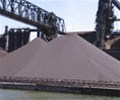Demand for iron ore declined during 2022, bringing export volumes down in most major markets, Brazil included. In its latest weekly report, shipbroker Banchero Costa said that “2022 was a rather negative year for global iron ore trade, primarily due to weaker demand worldwide and supply issues in Brazil. In January-December 2022, global iron ore loadings declined by -2.3% y-o-y to 1,518.2 mln tonnes, excluding cabotage, from 1,554.4 mln t in 2021, according to vessels tracking data from Refinitiv. Volumes were almost at par with the 1,525.6 mln tonnes shipped in 2019, but below the 1,557.2 mln tonnes shipped in 2018. Exports from Australia increased by +1.4% y-o-y in Jan-Dec 2022 to 896.3 mln t, above 2020 levels, and a new all-time record high. Exports from Brazil, on the other hand, declined by -2.1% y-o-y in 2022 to 339.7 mln tonnes. Volumes from South Africa declined by -5.7% y-o-y in 2022 to 53.6 mln t”.
According to the shipbroker, “demand has been poor everywhere. Iron ore imports into Japan declined by -7.7% y-o-y in 2022 to 90.7 mln t. Volumes into South Korea were down by -10.2% y-o-y to 70.2 mln t. To the European Union imports ended up down -1.6% y-o-y to 81.2 mln tonnes in the same period. Imports into the Arabian Gulf were also down by -10.8% y-o-y to 46.9 mln tonnes in 2022. Chinese imports also declined by -1.1% y-o-y to 1,077.2 mln tonnes in 2022, the lowest since 2019”.
Banchero Costa added that “Brazil is currently the second largest exporter of iron ore in the world, after Australia. In 2022, Brazil accounted for 22.4% of global iron ore shipments, after Australia’s 59.0%. South Africa is third with just a tiny 3.5% share. In the 12 months of 2021, Brazil exported 346.9 mln tonnes of iron ore, which was a +3.8% increase yo-y, from a low of 334.2 mln tonnes exported in the full year 2020. This was also higher than the low 340.5 mln tonnes loaded in 2019. It was however significantly below the 386.9 mln t exported by Brazil in 2018, or the 378.7 mln t in 2017. In 2022, activity softened again due to supply and logistical issues, with iron ore exports from Brazil declining by -2.1% y-o-y to 339.7 mln tonnes. Looking at major loading ports for iron ore in Brazil, we have: Ponta da Madeira (155.7 mln tonnes in 2022), Tubarao (59.6 mln t), Itaguai (59.6 mln t), Sepetiba Bay (26.8 mln t), Acu (21.0 mln t), Ponta Ubu (8.3 mln t), Itaqui (6.3 mln t)”.
“About 16% of exports from Brazil in 2022 were loaded on VLOCs (including Valemaxes), about 76% was loaded on Capesize tonnage, about 5% on Panamaxes, and 2% on Handymaxes. In terms of destinations of the shipments, things were relatively predictable in 2022. Mainland China was still by far the top destination for Brazilian iron ore, accounting for 67% of Brazil’s exports in 2022. Shipments to Mainland China declined by -2.1% y-o-y to 228.0 mln t in Jan-Dec 2022. This followed a -3.3% decline in 2021 from the very strong 240.7 mln tonnes shipped to China in 2020. Exports from Brazil to EU also declined by -2.5% y-o-y to 22.2 mln tonnes in Jan-Dec 2022. This is above the 18.5 mln t in 2020, but well below the 31.1 mln t in 2019. Shipments to the GCC countries increased by +5.2% y-o-y to 23.2 mln tonnes in 2022, building further on the +57.7% y-o-y surge in 2021. To Japan there was a -15.7% y-o-y contraction to 10.2 mln t in 2022 from 12.1 mln tin 2021, and also below the 12.3 mln t in 2019. Volumes to South Korea also declined by -11.1% y-o-y to 7.0 mln tonnes in 2022. Volumes to Malaysia (which is mostly for transhipment to other Asian destinations) contracted by -14.1% y-o-y in 2022 to 16.9 mln tonnes from 19.7 mln t in 2021, are essentially flat on the 17.0 mln t in 2020, and are also below the 21.6 mln t in 2019”, Banchero Costa concluded.
Source: Hellenic Shipping News





